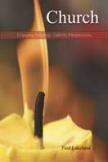New Directions
Books about “church” can treat a variety of things—bishops, clergy, the papacy and church buildings, among others. But Paul Lakeland, director of the Center for Catholic Studies at Fairfield University, insists that none of these are the church. His new book is, he assures, “about us, because we are the Church…the great majority of laity, for whom over the centuries it has been hard to say ‘Church’ and think ‘us.’” Intending to advance a lay responsibility that can press ordained leaders toward accountability, the book’s approach is resolutely inductive, starting from the grass-roots experience of church.
The book, part of the publisher’s series “Engaging Theology: Catholic Perspectives,” begins with a contemporary interpretation of the marks of the church: one, holy, catholic and apostolic. Holiness, linked to the question “What is the Church?” is treated first. Emphasizing that church refers to the entire religious family, Lakeland describes the community of faith grounded in a common commitment to Jesus Christ. All are called to be “other Christs”—in intimate relationship with him, enabling the message of Jesus to be heard by a changing world. The author compares this approach with a more traditional history of images for church, as found in the Second Vatican Council’s “Con-stitution on the Church.” In “When is the Church?” Lakeland writes, “There is only a Church when the teaching and person of Jesus has led a group of individuals to form a community somehow focused on his person.” That community, led by the Spirit, can be found in any and every age, and so we add “eternal” a new, fifth mark.
“Who is the Church?” deals with “oneness”: who is in or outside the church, particularly with regard to salvation. Oneness also embraces the relationship between the baptized and the ordained, and between the baptized and the rest of the world and other religions. “Where is the Church?” (Catholicity and the communion of saints) tackles the relation of local churches to the universal church and the role of Rome, and asks whether the universal has priority over the local parish.
Sacramentally speaking, Lakeland argues, “Rome is no more ‘the church’ than is your local parish.” In the new world of mission to others, in which the church “exists more for the sake of others than for its own sake,” it is the laypeople living in the world who are primarily charged with mission to the world. Taking apostolicity (“What is the Church for?”) seriously, the author emphasizes, requires looking “somewhat differently at the Church than what we are accustomed to do.” Here he drives home the book’s overarching theme: All the baptized are called to be apostles. The ordained are support staff, presently in much shorter supply, with the laity “shoulder[ing] by far the greater part of the task of being the loving presence of God in the world.”
The second chapter addresses the challenges, both internal and external, presently facing the church. Discussing dramatically changing patterns of institutional commitment, Lakeland suggests that the church needs “to learn a few lessons about how good teaching takes place.” He proposes ways of rethinking the qualitative distinction between the mission and ministry of the ordained and of the baptized. On the role of women in the church, given that the teaching of the magisterium seems not to have persuaded the faithful as a whole, he calls for a “better way of understanding tradition.” Other internal challenges include the role of individual conscience, the religious formation of the young and the scandal of sexual abuse, the latter being connected with what Lakeland terms the “closed system” of clericalism. The external challenges he examines include ecumenism, religious pluralism and the church’s role in political life. Lakeland also reviews the strengths that the church needs to build on: its liturgical life; the ministry of laypeople at work within the church; the catholicity of the church across time and space; the vitality of our characteristic American democratic values; and our fidelity to hope in the Lord, who calls us to be agents of change.
The third and final chapter explores the idea of an “inductive ecclesiology” for the 21st century, drawing insights from the works of Bernard Lonergan, S.J. In contrast to a deductive vision, an inductive approach does not trim the existing reality to fit the calcified models and images of the past. It understands that some insights from the past may still be true but no longer useful. The chapter carries forward the emphasis on the responsibility of the laity and the need for accountability by ordained leaders, particularly bishops. “If the adulthood of the laity means that they expect to be treated as equals, then an adult clergy is going to be a clergy that is not discomfited by a laity that treats them as equals, and that can return the favor.” Finally, Lakeland advocates a rethinking of all forms of ministry and urges consideration of open public discussion and debate in local communities of faith.
Church: Living Communion is, simply put, a tour de force. But Lakeland admits that even if laypeople apply pressure from below, “the requirement for a ‘decent consultation with hierarchy,’” is resisted by the hierarchical leadership. Yet the Catholic Church, he insists, must “take a step in the direction of being more what we are called to be…. Becoming subjects of our own history, with all that this means for adults, is long overdue for the Catholic laity.”
Lakeland has written a comprehensive, constructive and compelling work of ecclesiology.
This article also appeared in print, under the headline “New Directions,” in the February 1, 2010, issue.








